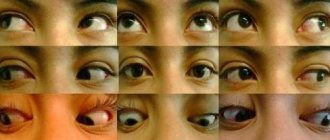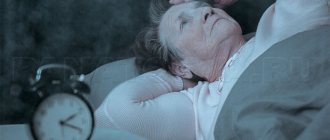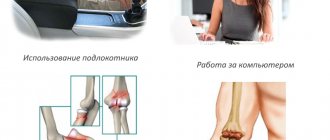Diogenes syndrome is one of the rarest psychopathological disorders, which occurs in only 3% of older people, and even less often in young people. It is characterized by pathological hoarding, indifference to one's own appearance (untidiness, sloppiness, lack of hygiene) and non-acceptance of criticism.
- Causes
- How does it manifest?
- Diagnosis and treatment
- Video on the topic
Other names for the disorder are senile squalor syndrome, pathological hoarding, Plyushkin syndrome (although Plyushkin syndrome is only part of the symptom complex). The main name of the disease comes from the name of the ancient Greek philosopher Diogenes, who led a normal life, but his home was a huge vessel located right on the street.
This diagnosis cannot be found in ICD-10, since Diogenes syndrome is not an independent disease. It is considered one of the symptoms of senile dementia.
Features of the disease, its symptoms and causes
The disease was first considered as a separate psychopathological syndrome back in 1966. The name “Diogenes syndrome” was proposed by British scientists in 1975. Today, there is constant debate about the correctness of this particular name for the disease; many psychiatrists consider the most appropriate terms to use are “syllogomania” or “senile squalor syndrome.” The fact is that the fundamental symptom of this mental disorder is the pathological accumulation of unnecessary things.
The ancient Greek philosopher, after whom the disease got its name, did not suffer from collecting unusable objects. He lived in poverty and the only object of his possession was a cup, which, in the end, the thinker broke due to the philosophical ideas of asceticism.
In domestic psychiatry, another name for this psychopathology is widely used - “Plyushkin syndrome”. As you know, this character in Gogol’s great poem was famous for his stinginess and craving for the accumulation of unnecessary things, with which he completely filled his home.
Among the main symptoms of the disease are:
- pathological hoarding;
- aggressiveness and negativism towards people who criticize the patient;
- lack of self-criticism of one’s condition;
- failure to comply with hygiene rules, sloppiness;
- stinginess;
- isolation from the public;
- apathy, indifference;
- lack of shame;
- self-neglect.
Collecting unusable things sometimes clutters up the home of pathological hoarders so much that it literally turns into a garbage dump. Hoarders take away various unnecessary items that, in their opinion, may come in handy sooner or later. The hoarder’s place of residence is sometimes so cluttered with all sorts of rubbish that it even becomes difficult to move around the house. People suffering from this syndrome drag everything from the street: from old, broken furniture to empty cardboard boxes, some even managed to store rotten vegetables and fruits. All this rubbish gives off an unpleasant odor, and cockroaches and rats often infest the room. The greatest discomfort is experienced by family members and neighbors living next to the pathological storage device.
As a rule, any criticism addressed to the patient is not accepted, and any offered help is immediately rejected. Pathological "Diogenes" after several complaints about their lifestyle become suspicious, taciturn and secretive. Sometimes it is simply impossible to establish contact with them; relatives have to resort to forcibly hospitalizing the patient (in extremely serious conditions).
Patients do not realize the seriousness of their condition; to many complaints they respond that this is their lifestyle, a hobby. According to the hoarder, any thing can be used: “old boards can be used to build a shed,” and “you can store something in empty tea boxes.” Guided by this principle, a person turns his life into an obsessive search for unusable objects.
The appearance of such people is unkempt; they often do not care about how they look. Neglect of hygiene makes them look like homeless tramps. When it comes to nutrition, syllogomanias are also not picky; as a rule, they save on food. There are many cases where patients ate scraps from landfills simply because they did not want to spend extra money on food. Basic necessities and medicines, according to pathological hoarders, are also not very important. Many patients do not leave the house for months, considering communication with people useless and boring. Neglect of one's health and social isolation sometimes lead to dire consequences. According to the facts, some recluses die completely alone, surrounded by garbage barricades.
Another sign of the disorder is a lack of shame. Syllogomaniacs may publicly relieve themselves, change clothes, or even undress. They are driven by indifference to what others think; their actions follow the principle of “I want and I do.” Often patients end up in the police department because of their shameless behavior and violation of the norms of order.
An interesting fact is that often people suffering from syllogomania are the owners of large savings, although they live like beggars. There are many cases where former rich and influential individuals became vagabonds, coming home only to bring more rubbish. Thus, one American millionaire was so stingy that at the age of forty he simply decided to live in a landfill in order to spend less.
Among the causes of the disease are:
- organic lesions of the frontal lobes of the brain;
- mental disorders of old age;
- alcoholism;
- pathological tendency to collect.
According to psychophysiological studies, the disease can occur as a result of damage to the frontal lobes of the brain. The cause of such lesions may be injuries, brain diseases, or unsuccessful operations. These areas of the cortex are responsible for making decisions, and it is their damage that leads to the development of a pathological craving for accumulation.
Sometimes syllogomania is only part of a serious mental illness. The syndrome most often occurs in obsessive-compulsive disorder, senile dementia,.
How it manifests itself
This disorder received the name “Diogenes syndrome” in honor of the ancient Greek philosopher, who was extremely unpretentious in appearance and lived, according to one version, in a barrel, and according to another, in a pithos (large clay vessel). However, Diogenes, on the contrary, was categorically against the accumulation of earthly goods and loved to communicate with people who strived for knowledge. Therefore, in the post-Soviet space the name Plyushkin syndrome is often used. This character from Dead Souls is more similar in behavior to people suffering from this disorder.
So, the main signs of Diogenes syndrome can be called:
- pathological passion for collecting and hoarding completely unnecessary things;
- aggression when trying to remove “all this garbage”;
- attempt to isolate, indifference to loved ones, avoidance of communication;
- indifference to significant events, political and economic situation in the country;
- pathological greed, the inability to part with a single thing;
- neglect of hygiene rules;
- lack of shame, indifference to moral norms and rules;
Patients with Diogenes syndrome drag into the house everything they can find: things, waste paper, food... All this lies in real heaps of garbage, preventing them from adequately using the apartment. The bath and toilet also turn into storage. Add to this the lack of desire to maintain hygiene and the lack of shame, which allows you to cope with biological needs wherever you want. Here is a sad picture of severe forms of this disorder.
Some unfortunate people do not limit themselves to objects and begin to collect stray dogs or cats. They think they are doing good deeds. But, in fact, these animals are simply doomed to a painful death.
Attempts to “restore order” on the part of relatives or neighbors are met with outright aggression. Patients begin to be cunning, hide, and avoid contact.
Most often, Plyushkin syndrome develops in older people. However, clinical studies revealed differences from the norm in the functioning of the frontal lobes. Therefore, there are cases of such behavior among young people, provoked by:
- intrauterine abnormalities in the development of the skull or brain, birth injuries;
- traumatic brain injuries;
- unsuccessful operations;
- diseases that affect the brain;
- neoplasms affecting the frontal lobes of the brain;
- alcoholism, drug addiction, substance abuse;
- long-term exposure to an unfavorable environment, hazardous production.
In addition, many authors tend to attribute acute stressful experiences caused by both personal significant events and general economic shocks or military actions to such factors. Thus, a large number of people with the mentioned syndrome were observed in the post-war period in Leningrad, which suffered a terrible siege.
There is an opinion that senile decay is more common in lonely people. However, such a statement can be disputed. The fact is that close people who are nearby naturally struggle with “deposits” of garbage. In addition, it is easier for them to obtain recognition of incapacity. But the neighbors have had to knock on the doorsteps of authorities for years and not sleep at night, waiting for a fire or simply suffering from the next batch of bedbugs from the neighbor’s apartment.
How to treat Diogenes syndrome
Therapy for the disease must be carried out without fail, since its symptoms can sometimes signal the development of more serious psychopathology.
So how to treat Diogenes syndrome? Sedatives, antidepressants, and antipsychotics are widely used as pharmacotherapy. Central to the diagnosis of the syndrome is a computed tomography scan of the brain to determine the extent of damage to areas of the brain. Psychotherapy, as a rule, is not used, since the basis of the disease lies in organic damage.
The main point in the treatment of the disease is family support and care. Often, Diogenes syndrome affects lonely people who are deprived of family love and mutual understanding.
Don't lose it.
Subscribe and receive a link to the article in your email.
Few people like sloppy people. Although there are people who do not take care of themselves at all and at the same time are geniuses in some field, this article will not be about them. We will talk about those people who have gone very far in their pursuit of hoarding and are completely oblivious to the mountains of garbage under their noses. Sometimes this indicates very strong mental disorders, and sometimes a completely ordinary person can be subjected to this.
People suffering from this syndrome are not adapted to life and experience great problems in life. The main problem is their lack of understanding and unwillingness to correct the situation, because it seems to them that everything is going well. Or they simply don’t care what other people think about them - even the people closest to them, friends and acquaintances.
Psychotherapy
However, it is very rare to come to an agreement. And psychological correction is impossible, since Plyushkin syndrome is of an organic nature, and patients do not have a critical attitude to what is happening. Treatment in a psychiatric institution is still considered the most rational.
This is what really scares many relatives. However, it should be remembered: the earlier such a patient takes therapy and is observed by a doctor, the slower the pathological craving for collecting will progress. Otherwise, do not forget that a fire in a cluttered apartment often claims the lives of both the owners and the unfortunate neighbors.
The extent of damage to the frontal lobes is determined using computed tomography. Drug therapy includes antidepressants, sedatives and antipsychotics.
But who could use the help of a psychologist are the relatives and friends of such Plyushkins. After all, at first you don’t want to admit the fact that your loved one has crossed the line of “frugality.” And then - it’s so difficult to remain calm when the shared home turns into a trash bin. But the health of your loved one depends on you and your sober assessment.
Lapshun Galina Nikolaevna, Master of Psychology, psychologist I category
Diogenes syndrome
in modern times it is studied under the close attention of specialists. The so-called pathological hoarding occurs in almost 2% of the total population of the planet. For some this is expressed in the accumulation of old and unnecessary things, and for others - in the accumulation of animals.
May progress and lead to poor results. For example, in tandem with other psychological disorders, hoarding can become a disease. Sometimes the police are faced with people littering their homes with garbage, not wanting to throw it away. And some people keep 40-50 cats/dogs at home, guaranteeing unsanitary conditions.
Concept and history of the term
Diogenes syndrome is a mental disorder characterized by extreme self-neglect, apathy, social isolation, lack of shame, and a tendency to hoard and collect stuff. The latter can lead to pathological hoarding, which is also a disorder.
This syndrome was recognized by psychologists in 1966. The syndrome got its name from the ancient Greek philosopher Diogenes. He was a proponent of extreme minimalism and, according to legend, lived in a large clay vessel. However, there are also differences in the life of Diogenes himself and the people who are characterized by this term. Diogenes sought communication with other people and did not engage in hoarding. Therefore, a number of researchers consider the name of the syndrome to be incorrect and propose to call it, for example, Plyushkin syndrome.
It is believed that this syndrome is caused by disturbances in the frontal lobe of the brain. Nevertheless, there are quite adequate people who simply don’t care where to live or how to dress. They focus on completely different things - from art to science. Therefore, it is quite difficult to distinguish a clinical case from a case in which a person is simply very busy with other things.
Diagnostics
Patients are examined by a psychiatrist, a clinical psychologist and a neurologist. The task of the diagnostic stage is to detect the characteristic symptoms of the disorder and their physiological substrate, differentiation from other mental illnesses that manifest themselves in a similar way (antisocial behavior, sloppiness, hoarding). The main research methods are:
- Conversation.
Since patients are not critical of their own illness, the examination takes place in the presence of relatives. The main complaints are the desire to collect and store unnecessary things, refusal of hygiene, extreme social isolation, lack of a sense of shame. Based on the results of the conversation, the doctor differentiates the syndrome with pathological hoarding with obsessive behavior and schizophrenia. - Observation.
Patients behave warily, refuse to answer questions, and have a negative attitude towards doctors and other medical personnel. They are outwardly unkempt, do not keep their distance when communicating, and are tactless. - CT scan of the brain.
Instrumental diagnostics can detect changes in specific areas of the brain and determine the extent of damage. Computed tomography may be replaced by other tests, such as MRI. - Psychodiagnostics of the cognitive sphere.
The study of cognitive processes is necessary to identify dementia and schizophrenia. In these diseases, the primary factor is a decrease in intellectual abilities or a distortion of perception and thinking, and not emotional and personal deviations, which is characteristic of Diogenes syndrome.
Main symptoms
We have already touched on some symptoms in the definition of the term. Many people are susceptible to this syndrome and their symptoms may vary slightly. However, the following symptoms are common to most who experience this disorder.
- Self-neglect.
- Indifference, apathy.
- Isolation from the public.
- Stinginess.
- Failure to comply with hygiene rules.
- Sloppiness.
- Pathological hoarding.
- No shame.
- Lack of self-criticism.
- Aggression towards.
With pathological hoarding, the home of such people looks like a landfill. We are not talking about cleaning at all. Even simply moving between rooms can be difficult. Such people drag everything from the street: empty cardboard boxes, old furniture, strollers and other unnecessary things. The situation worsens due to the unpleasant smell, as well as the appearance of various living creatures.
Causes of the disease
There are four main reasons.
- Alcoholism.
- Mental disorders of old age.
- Damage to the frontal lobes of the brain.
- Pathological tendency to hoard.
The frontal lobes of the brain can be damaged as a result of injury or botched surgery. These areas are responsible for making decisions, so damage to them can lead to hoarding. Diogenes syndrome is often preceded by severe mental illness. For example, Pick's disease.
Origin and specificity of the syndrome
Diogenes syndrome or pathological hoarding does not occur on its own. This is usually facilitated by microtrauma of the cerebral cortex in a certain area. For many, this occurs with age, after 50 years. And often this diagnosis is given to people who have signs of a mental disorder (schizophrenia and the like).
Experts have long conducted research to study the activity of certain areas of the cerebral cortex. It turned out that the cause of the problem is hyperfunction and hypofunction of different parts of the brain. In 60% of cases, hoarding syndrome is accompanied by other diseases. For example, dementia (dementia or insanity). This is especially true if a person suffers from collecting animals in excessive quantities.
Treatment methods
The difficulty is that people suffering from this syndrome do not realize that they need help, so they do not seek it. In this regard, responsibility should fall on the shoulders of relatives and friends. They must recognize this disease and send him for treatment.
Such a person should be convinced at first to refrain from bringing whatever he wants into his home. Since trash acquires great value in his eyes and he is sure that all this will definitely be useful to him, it is necessary to gradually reduce this dependence. Let it be only books and magazines. They themselves can bring significant benefits. It is also worth helping him with cleaning and being able to convince him that this will be of great benefit.
The patient's skill will be of great benefit. He must understand that this way of behavior spoils all areas of his life. Motivation in the recovery process is of great importance because, essentially, taking a shower and keeping your apartment in order is quite easy. The patient must understand that he himself needs this, because it does not even occur to him how he is ruining his life.
If a patient suffers from alcoholism, the first step is to rid him of this addiction. There is a chance that after this everything else will work out on its own.
Therefore, if you have such friends or relatives and you care about them, try to help them. Because this may lead to the fact that such a person one day decides to light a fire in his own living room with understandable consequences. We wish you good luck in this difficult task!
Diogenes syndrome (senile squalor syndrome, pathological hoarding syndrome, syllogomania) is a mental disorder that manifests itself as social isolation, apathy, and neglect of one’s own appearance and personal hygiene. This condition is more common in elderly patients.
Treatment of pathological hoarding syndrome
What should the relatives, friends, and neighbors of such plushkins do? The answer is quite simple - since Diogenes syndrome has already been described in medicine and is part of many diseases, the patient needs to be examined and treated. The patient, of course, should be consulted by a psychiatrist, who will prescribe outpatient treatment or suggest hospitalization. However, as a rule, such patients do not realize the presence of the disease and do not want to be treated at all. Therefore, both relatives and neighbors have to somehow get along with the Plyushkin-Diogenes.
At the initial stages, it is recommended that loved ones negotiate with the patients and try to direct their passion for “collecting” into a peaceful direction. You should periodically help with cleaning to prevent complete clutter in advance. It is worth explaining to our heroes that it is inconvenient to walk in their room, and there is nowhere to sit, thereby awakening a “healthy consciousness.” A person should feel that he is needed by others, loved by his loved ones. The more firmly he is integrated into society, the less the disease will manifest itself.
Naturally, drug treatment should be started as early as possible. Nootropic and vascular drugs with a predominantly calming effect help well. They improve memory, attention, mental activity and performance. It also makes sense to use anti-neuroleptics - “mild” drugs with predominantly anti-anxiety, behavior-regulating, relaxing and antidepressant effects. Patients become calmer, more cooperative, and more adequate emotionally; partial criticism of one’s condition and behavior appears. As my practice of working with such patients shows, psychotherapy in these cases is practically useless, since we are dealing with damage to the substance of the brain.
If the illness has gone far and it is impossible to come to an agreement with the patient in any way, his home becomes dangerous for others and the occupant himself, and he refuses to be treated at home, then, of course, treatment in a psychiatric hospital is necessary, even without the patient’s consent. You can read about involuntary hospitalization in a psychiatric hospital in the “Law on Psychiatric Care and Guarantees of the Rights of Citizens in its Provision.”
Conclusion
In my own practice, I encountered patients with Plyushkin syndrome (as we traditionally call this disorder) dozens of times, but I remember one of the first cases best. It was also interesting because the victims of the disease were elderly spouses - husband and wife. Now it is difficult to say whether their disease developed independently, synchronously, or whether one induced the other. My colleague, their housemate, described how in the mornings the old people would get out of their apartment crammed with things - in search of new loot, which was collected from all the nearby garbage cans. The most valuable (at least in their understanding) things were tied into a bag of several sheets; a rope was attached to the bag. The old men walked leisurely through the city and took turns dragging the bag along the asphalt...
This story had a completely natural ending. While the couple simply collected and accumulated garbage, few people paid attention to them, except that the smell from the apartment annoyed the neighbors. But one fine day they decided to make a fire right on the floor of the living room... That’s how we met in a mental hospital. It is noteworthy that these patients generally made a fairly pleasant impression. Polite, friendly, smiling - they were very worried about each other (since they were in different departments). At the same time, they did not at all give the impression of being weak-minded, although there was some decrease in intelligence and memory. They quite reasonably explained their passion for hoarding with a difficult life and a small pension: “You throw something away, and then you’ll need it later... It’s more convenient for us this way...”.
As far as I remember, after a relatively short treatment in the hospital, they were registered in a nursing home, in order to avoid further littering of the apartment and, even more so, arson.
In conclusion, I can only advise readers to keep their home clean and tidy, not to become overgrown with unnecessary rubbish, take care of themselves and often think: are the people around you as comfortable with you as you are with them?
1. Guide to psychiatry in 2 volumes, edited by Academician of the Russian Academy of Medical Sciences A. S. Tiganov, Moscow, “Medicine”, 1999.
2. Child psychiatry. Textbook edited by E. G. Eidemiller, St. Petersburg, 2005.
3. Psychiatry. Textbook for students, M. V. Korkina, N. D. Lakosina, A. E. Lichko, I. I. Sergeev, Moscow, “MEDpress-inform”, 2006.
4. V. M. Bleikher, I. V. Kruk. Explanatory dictionary of psychiatric terms, Voronezh: NPO "MODEK", 1995.
5. D. Macmillan, P. Shaw Senile breakdown in standards of personal and environmental cleanliness. BMJ, 1966.
6. ANG Clark, GD Mannikar, I. Gray Diogenes syndrome: a clinical study of gross self-neglectin old age. Lancet, 1975.
7. M. Orrell, B. Sahakian “Dementia of frontal type.” Psychol Med, 1991.
Diogenes syndrome (senile squalor syndrome) is a mental disorder that manifests itself mainly in older people. Those suffering from this disorder are characterized by an obsessive desire to collect unnecessary, worthless, old things, neglect the rules of hygiene and have no sense of shame. Diogenes syndrome is diagnosed in approximately 3% of older people.
Etiology
Pathological hoarding was first described in the literature in 1966 by American psychiatrists. This condition can occur after a traumatic brain injury, neurosurgery, or certain infectious diseases. Pathological hoarding is often observed in people suffering from chronic alcoholism.
The occurrence of Diogenes syndrome is associated with damage to the frontal lobes of the brain. A magnetic resonance imaging scan revealed pathological activity in the area of the cingulate gyrus and insula in situations where they were faced with a choice - throw away an item or keep it. Moreover, the item did not represent any material or spiritual value.
The majority of patients are elderly. Pathological hoarding is more likely to develop in people who are prone to collecting unnecessary things or collecting things. This type of personality is characterized by secrecy and self-isolation. People who experienced hardships in their youth (hunger strike, post-war years) tend to stock up for a “rainy day,” which can develop into a pathological condition.
Clinical picture
Pathological hoarding was mistakenly called Diogenes syndrome. The famous philosopher led a marginal lifestyle due to his philosophy, and not his psychological state. Plyushkin from Gogol’s “Dead Souls” depicts the picture of the disease more realistically.
Psychiatrists identify several leading manifestations of syllogomania:
The American Psychiatric Association uses a 5-point scale to determine the degree of disease progression. The number of points depends on the degree of clutter in the room, the patient's appearance, and the ability to take care of oneself independently.
Pathological hoarding can manifest itself not only in the senseless collection of unnecessary things: some patients, especially lonely people, pick up stray animals; they cannot provide them with proper care and nutrition, which leads to rapid contamination of the home and disputes with neighbors.
Therapy methods
Treatment of Diogenes syndrome is complex. Tricyclic antidepressants and antipsychotics are successfully used as medications. If the cause of the disease is organic damage to parts of the brain, then, if possible, treat the underlying disease.
Treatment with psychotherapy rarely leads to complete healing, but it makes the symptoms of the disease less pronounced. The patient's relatives should not behave aggressively. Support and understanding of the situation is very important. You should not try to throw things away on your own, as this behavior can lead to a worsening of the condition. It is better to treat Diogenes syndrome on an outpatient basis with the support of loved ones.
At the initial stages of treatment, relatives can try to negotiate with the patient about so-called “selective collecting.” For example, he may only bring home magazines or old toys. It is also necessary to agree on maintaining cleanliness and order in the house.
Diogenes syndrome often affects lonely people. Therefore, doctors recommend that relatives visit such patients more often and spend more time with them.
Rating:
Diogenes syndrome is a mental disorder characterized by the desire to collect and accumulate various unnecessary things (syllogomania), sloppiness, social isolation, etc.
A particular deviation in behavior was named after the legendary ancient Greek philosopher, who went down in history thanks to his extreme unpretentiousness and living in a barrel (according to another version, in a large clay vessel). Many modern experts consider it not entirely correct, since Diogenes did not strive for material values, preferring spiritual food to them.
The phenomenon of pathological hoarding has been familiar to psychiatry for centuries. The term “Diogenes syndrome” was officially coined in 1975 in the works of psychiatrists Mainkikar, Clark and Gray.
In domestic medicine, the disease is better known as social decay, senile squalor or Plyushkin syndrome (by analogy with the behavior of the character in “Dead Souls” by N.V. Gogol).
The syndrome is especially common in European countries. It is diagnosed in 3% of people over 65 years of age. There are known cases of deviations occurring among younger patients.
The history of greed - to the origins of the causes of pathological hoarding
Morbid hoarding has been known to people throughout the entire documented history of their existence. For example, in the Church Slavonic language there was even a special name for collecting things - msheloystvo, and according to Orthodox traditions it is considered a sin. Since childhood, we have been familiar with Russian fairy tales about Kashchei. The disease is also reflected in works of art: let us recall, for example, the painting “The Death of a Miser” by Hieronymus Bosch, Pushkin’s “The Miserly Knight”, Ebenezer Scrooge, the same old man Plyushkin, who gave another name to our syndrome. All of these stingy people are, to one degree or another, related to the problem at hand - pathological hoarding.
Until 1966, psychiatrists viewed this problem as a subtype of obsessive-compulsive disorder. The English psychiatrist D. Macmillan in the British Medical Journal was the first to describe Diogenes syndrome as an independent disorder. He gave it the name “Senile breakdown in standards of personal and environmental cleanliness,” which roughly translated sounds like “Senile decline in standards of personal and household hygiene.” Thanks to British psychiatrists A. Clarke, G. Meinikar and J. Gray in 1975, the disorder was called “Diogenes syndrome, or syndrome of senile squalor.” It is this name that has stuck and is now used everywhere.
It should be noted that in the International Classification of Diseases, 10th revision, Diogenes (Plyushkin) syndrome is not included as an independent disease. This is explained by the fact that it is observed in a number of lesions and diseases of the brain that have different causes and occur with different manifestations, among which the dominant ones are considered to be disorders of cognitive functions and emotional-volitional status, as well as the presence of psychotic inclusions (including dementia, schizophrenia , consequences of alcoholism). Diogenes (Plyushkin) syndrome itself seems to fade into the background. Therefore, traditionally we consider Diogenes syndrome within the framework of organic diseases of the brain with changes in the patient’s personality.
The ancient Greek philosopher Diogenes of Sinope (404-323 BC, one of the founders of the Cynic school) was distinguished by his extreme unpretentiousness in everyday life and built his home in a clay barrel at the temple. The philosopher did not need property at all: he professed asceticism and sought human communication. Thus, “Diogenes syndrome” is not an entirely correct name, and a number of researchers suggest using other options: senile disorder, Plyushkin syndrome (a character from Gogol’s novel “Dead Souls”), social decay, senile-squalor syndrome.
Typical picture of patient behavior
A typical picture of the course of the disease is as follows: the room where Plyushkin lives is filled with unnecessary rubbish (waste paper, old clothes, spoiled food, parts, furniture). In most cases, all these valuables end up in the home from trash cans. Patients often bring animals, including dead ones, into the house.
The situation is developing in the most critical way. Against the background of senseless collecting, the patient’s active disregard for his own person, apathy and isolation are observed.
The accumulation of rubbish leads to unsanitary conditions, from which those around us suffer the most. In response to attempts to put all the trash back in the trash, the patient expresses a violent protest, becomes taciturn, begins to be cunning and avoid communication with others.
In most cases, people with senile squalor syndrome are perceived from the outside as unfortunate and half-starved poor fellows. Often the situation is completely different. Despite their unkempt appearance, they can have caring loved ones and relatives, as well as considerable financial fortunes.
Causes and symptoms of the development of the disorder
Most often, Diogenes syndrome develops in old age due to experienced and severe shocks.
A large number of people with a similar deviation appear after events on a global scale - wars, famines, global disasters.
Other causes of the disease include:
- generic and ;
- neoplasms in the frontal lobes of the brain;
- adverse consequences of operations;
- alcohol and drug abuse;
- pathological dependence on collecting;
- long-term loneliness.
Cases of the disease can also be triggered by hazardous production or other adverse environmental influences.
Symptoms of the disease at an early stage do not cause much concern among others. Often there is a constant creative disorder in the patient’s room, which he explains by being very busy.
Some time later, the symptoms become more pronounced, symptoms of progression of Plyushkin syndrome:
- reverent storage of old unnecessary things and reluctance to get rid of them;
- constant disorder, refusal to keep the room clean;
- neglect of personal hygiene and appearance;
- isolation, antisocial behavior;
- aggression when others try to change the situation;
- pronounced greed and frugality;
- indifference, dulling of the feeling of shame.
Due to neglect of hygiene, the patient may develop various infections and skin diseases. In this case, the patient often categorically refuses treatment even at home. There comes a moment of complete alienation from the surrounding reality.
Prognosis and prevention of dementia
The prognosis for senile poverty is most often unfavorable. Care provided to the patient on an outpatient basis or in a medical facility stabilizes the condition only for a while. In many cases, the achieved rehabilitation is gradually replaced by the previous degrading state.
Doctors say Diogenes syndrome can be prevented thanks to timely preventive measures. Avoiding a passive lifestyle, moderate exercise, and daily exposure to fresh air can help reduce the risk of developing the disorder. Mental activity brings benefits - regular reading, intellectual games, solving crosswords, learning foreign languages. Elderly people are advised to eat well and get enough sleep, monitor their heart condition, monitor blood pressure and blood sugar levels, and prevent excess weight gain.
Our materials will be useful for you and other users. Share the article on social networks! Click!
Diogenes syndrome or pathological hoarding is a mental disorder, a type of obsessive disorder. It manifests itself in the fact that a person collects and accumulates a huge number of things and objects, mainly household items. who suffers from this pathological hoarding disorder experiences agony even if she has to throw away a plastic bag or jar. Interestingly, the ancient Greek philosopher Diogenes of Synod was known for his asceticism and unpretentiousness in everyday life. Therefore, the above name for this pathology is considered not entirely correct. The names “Plyushkin syndrome” or “senile squalor syndrome” are increasingly being used.
Symptoms and causes of the disease
The main symptoms of pathological hoarding are living among heaps of rubbish brought from the street, an interest in garbage, neglect of personal hygiene and a hostile, sometimes aggressive attitude towards others who pay attention to the patient’s strange hobby. Such people do not consider their hobby to be a collection of garbage - they are sure that each of the things has a certain value and will certainly come in handy someday. However, the last thing they need is money, carefully collecting their savings in secluded corners or in the bank.
Scientists who have been studying the causes of this disease for a long time have found that the desire to collect something is initially inherent in the human brain. Some of us collected stamps, badges, others – postcards, coins and even chewing gum candy wrappers. Over time, this passion for collecting passes for some, while for others it turns into an obsessive desire. And then it is very easy to cross that barrier when a harmless hobby develops into a real illness. According to research, people who suffer from an uncontrollable habit of collecting everything in their path show certain differences in the structure of the cerebral cortex. This is especially true for the weak development of the cortex of the frontal lobes of the brain - this is where the center is located, which is responsible for the rationality of actions.
When the activity of this part of the brain decreases, a person begins to perform completely illogical actions. Diogenes syndrome, especially in the early stages, is quite difficult to diagnose; it can be confused with a complex character or eccentricity. Some of the reasons for the development of this disease may also be a previous head injury, severe loss, bereavement, loneliness, surgical interventions in the head area, as well as previous encephalitis. Scientists have proven that most often quite successful, educated people who previously led a fairly active lifestyle and enjoyed success in society fell ill with Diogenes syndrome.
How to treat Diogenes syndrome?
Since Diogenes syndrome has been studied by medicine and is a consequence of many diseases, it certainly needs to be diagnosed and treated. It occurs mainly in old age, although there are cases among young people. Treatment of Diogenes syndrome at the initial stage allows you to do without medications. First of all, this is the attention of relatives. You need to be more interested in the collected collections, motivate the patient to put things in their designated places, offer help in cleaning in order to get rid of very old exhibits.
If a person needs to take medications, then after consultation with a psychiatrist, he will be prescribed a number of medications that improve memory, mental activity and attention. Patients become more active and emotional, and more self-critical. Sometimes it happens that the disease has gone too far and a person’s home becomes dangerous both for himself and for those around him. If he refuses to be treated at home, then treatment in a psychiatric hospital is required legally, even without his consent.
Diogenes syndrome (senile squalor syndrome) is a mental disorder that manifests itself mainly in older people. Those suffering from this disorder are characterized by an obsessive desire to collect unnecessary, worthless, old things, neglect the rules of hygiene and have no sense of shame. Diogenes syndrome is diagnosed in approximately 3% of older people.
Stages of the disease
In neurological practice, there are several stages of Diogenes syndrome:
Despite the fact that such phenomena cause much ridicule, their consequences are quite serious. The patient risks his own life and health, endangers others, and his home is also at risk. There is a risk of injury, fire, development and spread of infections, invasion of cockroaches, bedbugs, rats, etc.
When the situation goes too far and a constructive dialogue with the patient is impossible, compulsory treatment in a psychiatric hospital is indicated.
Stages of Plyushkin Syndrome
Doctors distinguish at least five stages of the pathological condition:
| First stage | Lack of order in a patient's room is perceived as the norm. The room is not yet filled with rubbish, the patient’s behavior does not arouse suspicion. |
| Second stage | Garbage accumulates in the house; bins or buckets are often overfilled. The home is filled with unpleasant odors, and the first mold appears. |
| Third stage | There are piles of rubbish in the apartment blocking the passages. Unsanitary conditions and stench reign everywhere. |
| Fourth stage | There are no normal living conditions. The plumbing and furniture are in poor condition, and a large amount of mold is found. |
| Fifth stage | The patient's home is uninhabitable. There is serious damage to the walls and ceiling. Neighbors complain of discomfort and stench emanating from the patient’s apartment. |
A patient who has reached the final stage of Diogenes Syndrome risks his own health and life. His home often poses a threat to people living nearby. The risk of reproduction of bedbugs, cockroaches, rats, fires, and flooding increases.
If the situation becomes critical, and the patient with Diogenes Syndrome does not enter into a constructive dialogue, forced hospitalization in a psychiatric hospital is carried out.
Treatment of involuntary Diogenes and Plyushkins
It is used as a reliable method for diagnosing pathological hoarding. As a result of the research, the degree of damage to the brain areas and the presence in them is revealed. In addition to the examination, a consultation with a psychiatrist is required.
The International Classification of Diseases does not classify Plyushkin syndrome as an independent disease. It can accompany a number of diseases and brain lesions, accompanied by changes in the patient’s personality.
Diogenes syndrome is sometimes confused with shopaholism. However, these are different diseases. “Plyushkin” is not able to part with things, and at the same time he is extremely frugal. A shopaholic easily spends money and just as quickly loses interest in the purchased item.
To date, a method of completely getting rid of the disease has not been developed. Despite this, there is always a chance to change things. An integrated approach to treatment with the participation of loved ones and doctors can help a person and to some extent reduce the manifestations of the syndrome.
The disease is based on organic damage, so psychotherapy does not lead to a pronounced effect. They also help to alleviate the condition. They contribute to greater compliance and adequacy of the patient.
His relatives can greatly influence the improvement of the patient’s condition. Their attitude should be understanding and patient.
Relatives should surround their loved one with care and love. Dialogue remains the most effective means. Only through persuasion and conversations can the situation improve.
Forecasts
Many psychiatrists, studying Diogenes syndrome, wondered how to get rid of this disease. Unfortunately, today treatment for Diogenes syndrome is aimed at slowing down degenerative processes and does not affect existing disorders.
It is extremely important to create a safe environment for patients with Diogenes syndrome.
Relatives and loved ones need to mentally prepare for the fact that the person they once knew has changed a lot and is unlikely to become the same.
The patient needs to be provided with everyday life, proper sanitary conditions, live communication, and be occupied with feasible activities. This will help create the most favorable environment for future life.
We also recommend
- Good night wishes to dear Tatyana Good night wishes in verses for your beloved girl
- Beautiful and funny wishes for good night (good evening) to your beloved girlfriend, beloved boyfriend, man, woman, friend, girlfriend, husband, wife in your own words at a distance
- Personal experience: how I cured acne
- Gel for gums during teething in babies: review of products, reviews
- Restoring the body after childbirth
- Cytokines and inflammation What are cytokines in medicine
What are the consequences?
Pathological hoarding poses a great danger, primarily for the patient himself. It can significantly undermine one’s own health and pose a danger to society. In addition, the disease is characterized by rapid progression, leading to the destruction of personality.
The results of numerous studies indicate a high probability of an unfavorable prognosis for syllogomania. Help at home or in a specialized institution can stabilize the condition for a certain time. However, subsequent rehabilitation often ends with the patient returning to his previous degraded state.
The definitive nature of cases of this disorder and the development of effective treatments are still under scientific investigation.










